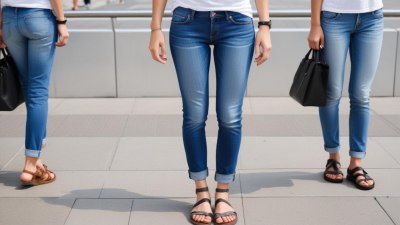How Weather Makes You Think You Need a Whole New Personality (and Wardrobe)
Explore how changing weather influences our personality and fashion choices, shaping self-expression and mood.

Image by lookstudio on Freepik
The weather is not just a backdrop of our daily lives; it’s a canvas that influences our thoughts, emotions, and even our sense of identity. Sunlight can energize us, while rain may dampen our spirits. The impact of weather on our mood and self-perception can be profound. Many people find themselves reassessing their wardrobe, style, and sometimes even their personalities as the seasons change. In this article, we explore how various weather patterns can make you feel like you need a whole new personality, along with a corresponding update to your wardrobe.
Seasonal Affective Disorder: The Weather-Personality Connection
Seasonal Affective Disorder (SAD) is a type of depression that occurs at certain times of the year, usually in the winter months when there is less natural sunlight. This condition can lead individuals to feel less like themselves and prompt them to make drastic changes in their lives. During cloudy weather or cold seasons, people might gravitate towards cozy, muted clothing that reflects their inner emotional state. They may even alter their personalities to fit what they feel society expects from someone who is experiencing winter blues.
Spring Awakening: Rebirth and Renewal
As winter melts away and spring blooms, many individuals experience a sense of rejuvenation. This is a time of renewal, often reflected in bright colors and fresh styles. People tend to shed heavier, darker clothing. With the arrival of warmer weather, there is a psychological shift that encourages individuals to embrace new beginnings. This often includes an updated wardrobe filled with light fabrics, vibrant colors, and a more playful spirit. Personality traits associated with generosity and sociability may also surface as people begin to shed their winter selves.
Summer: Heat and Self-Expression
Summer is characterized by warmer temperatures and longer days, encouraging outdoor activities and social interactions. The heat can bring a sense of liberation, prompting many to express their individuality through varied fashion choices, from bold prints to shorts and swimsuits. This time of year can embolden people to try new things, whether it’s adventurous patterns or engaging in new hobbies. As the day extends into night, the energy of summer can lead to spontaneous personalities filled with optimism and excitement. Many find themselves more outgoing and willing to take chances with their wardrobe choices, reflecting a desire to stand out and truly be themselves.
Autumn: The Shift to Cozy
With the arrival of autumn, there comes a shift that often brings about introspection. The leaves change their colors, and the weather turns crisp. This time of year can evoke feelings of nostalgia and comfort. Many people find themselves wanting to wear earthy tones, layering their clothing in preparation for colder days. As we bundle up, there’s an analogy to wrapping oneself in warmth and security, which can lead to a desire to retreat inward, sparking a more reflective personality. This can also manifest in creative expressions, as individuals explore various artistic outlets and delve deeply into their thoughts.
Weather and Identity: The Psychology of Dressing
The psychology of dressing can greatly change with the weather. Warm, sunny days can lead to carefree attitudes and more expressive clothing choices, while cold, rainy days may evoke a preference for comfort that comes with heavier and darker attire. This cyclical change influences how individuals perceive themselves and are perceived by others. It’s fascinating how a gray day can make colorful street fashion feel overly extravagant, or conversely, how a sunny warm day can seem completely dull without vibrancy in one’s outfit.
Fashion as a Reflection of Mood
Our fashion choices are often reflections of our inner moods, which are heavily influenced by the weather. A bright and sunny day might lead someone to wear cheerful colors, while a gloomy, rainy day could prompt darker, more muted styles. Psychologically, clothing can serve as a barrier against outside moods or a way to resonate with them. Therefore, people may feel a need to adjust their wardrobe to align with changes in the weather but also to express or conceal their emotional health. This phenomenon is noteworthy, as it underlines how intertwined fashion and emotions are shaped by external factors.
Impact on Self-Confidence
The desire to shift one’s personality and wardrobe during seasonal changes can also root itself in self-confidence, or a lack thereof. For example, on sunny days, people often feel more confident, willing to wear bold prints or bright colors. Conversely, during rainy or wintery weather, individuals may feel the need for security and comfort through their clothing choices, often opting for muted, neutral tones. This speaks to an overarching theme: how the ambiance around us can significantly influence our feelings of self-worth and identity.
Exploring New Styles
Weather changes can motivate individuals to experiment with styles they wouldn’t normally consider. The transition from one season to another can prompt personal growth, pushing someone to explore new avenues of self-expression. Fashion, in this context, becomes a means of reinvention. As summer fades to fall, one might swap out floral prints for plaid, all while cultivating a sense of renewal in their personality.
Community and Social Influence
The weather can also affect communal activities, leading to social gatherings. The summer heat often brings community events and outdoor activities, leading to a collective feeling of openness and freedom. In contrast, winter may lead to a more insular mentality, as the inclination is typically to stay indoors. This societal interaction heavily influences personal clothing choices. Fashion trends can arise from these social contexts, emphasizing the effect that both individual psychology and weather patterns have on personal identity.
Climate Change and Evolving Personalities
As climate change alters seasonal norms, some individuals are experiencing feelings of disconnection with their traditional roles or identities. People might feel the need to adapt their personalities, reflecting a more climate-conscious lifestyle through their clothing choices. For instance, an increase in awareness about sustainability can lead to selecting eco-friendly fabrics or second-hand shopping. This newfound perspective on fashion can foster a sense of pride and purpose, which is empowering in the chaotic realm of climate change.
The Future of Weather-Personal Identity
As we move into a future with changing weather patterns and societal evolution, our perception of identity will continuously adapt. Innovations in fabric technology may provide weather-responsive fashion choices that balance personal expression with practicality. People’s relationships with their wardrobes might become more fluid, allowing them to shift between personalities depending on external variables like the weather. This chronicle of self-expression, influenced by weather, challenges the rigidity of self-identity while emphasizing the need for adaptability.
In conclusion, weather profoundly affects our moods, personalities, and fashion choices. Each season brings its own character, reshaping how we express ourselves and how we feel in relation to the world around us. The connection between the weather and personal identity emphasizes the dynamic interplay between external influences and internal experiences. As climate patterns evolve, this relationship will only deepen, underscoring the importance of celebrating change and personal growth. So next time you feel the urge to swap out your wardrobe or shake up your personality with the changing seasons, remember that it’s not just about clothing; it’s an evolving narrative of who you are and how you navigate through the world.











